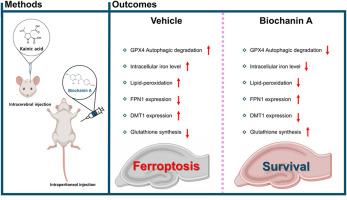Biochanin A inhibits excitotoxicity-triggered ferroptosis in hippocampal neurons
IF 4.2
3区 医学
Q1 PHARMACOLOGY & PHARMACY
引用次数: 0
Abstract
Excitatory neurotransmitter-induced neuronal ferroptosis has been implicated in multiple neurodegenerative diseases such as Alzheimer's disease and Parkinson's disease. Although there are several reports pertaining to the pharmacological activities of biochanin A, the effects of this isoflavone on excitotoxicity-triggered neuronal ferroptosis remain unclear. In this study, we demonstrate that biochanin A inhibits ferroptosis of mouse hippocampal neurons induced by glutamate or the glutamate analog, kainic acid. Biochanin A significantly inhibited accumulation of intracellular iron and lipid peroxidation in glutamate- or kainic acid-treated mouse hippocampal neurons. Furthermore, biochanin A regulated the level of glutathione peroxidase 4, a master regulator of ferroptosis, by modulating its autophagy-dependent degradation. We observed that biochanin A reduced the glutamate-induced accumulation of intracellular iron by regulating expression of iron metabolism-related proteins including ferroportin-1, divalent metal transferase 1, and transferrin receptor 1. Taken together, these results indicate that biochanin A effectively inhibits hippocampal neuronal death triggered by glutamate or kainic acid. Our study is the first to report that biochanin A has therapeutic potential for the treatment of diseases associated with hippocampal neuronal death, particularly ferroptosis induced by excitatory neurotransmitter.

生物变色素 A 可抑制兴奋毒性触发的海马神经元铁突变。
兴奋性神经递质诱导的神经元铁氧化与多种神经退行性疾病(如阿尔茨海默病和帕金森病)有关。虽然有一些关于生物黄酮 A 药理活性的报道,但这种异黄酮对兴奋性毒性诱导的神经元铁氧化的影响仍不清楚。在这项研究中,我们证明生物黄酮 A 能抑制谷氨酸或谷氨酸类似物凯尼酸诱导的小鼠海马神经元的铁突变。生物变色素 A 能明显抑制谷氨酸或凯尼酸处理的小鼠海马神经元细胞内铁的积累和脂质过氧化。此外,生物变色素 A 还能通过调节谷胱甘肽过氧化物酶 4 的自噬依赖性降解来调节其水平,而谷胱甘肽过氧化物酶 4 是铁变态反应的主要调节因子。我们观察到,生物变色素 A 通过调节铁代谢相关蛋白(包括铁转运蛋白-1、二价金属转移酶 1 和转铁蛋白受体 1)的表达,减少了谷氨酸诱导的细胞内铁积累。综上所述,这些结果表明,生物变色素 A 能有效抑制谷氨酸或凯尼酸引发的海马神经元死亡。我们的研究首次报道了生物变色素 A 具有治疗与海马神经元死亡相关疾病的潜力,特别是兴奋性神经递质诱导的铁中毒。
本文章由计算机程序翻译,如有差异,请以英文原文为准。
求助全文
约1分钟内获得全文
求助全文
来源期刊
CiteScore
9.00
自引率
0.00%
发文量
572
审稿时长
34 days
期刊介绍:
The European Journal of Pharmacology publishes research papers covering all aspects of experimental pharmacology with focus on the mechanism of action of structurally identified compounds affecting biological systems.
The scope includes:
Behavioural pharmacology
Neuropharmacology and analgesia
Cardiovascular pharmacology
Pulmonary, gastrointestinal and urogenital pharmacology
Endocrine pharmacology
Immunopharmacology and inflammation
Molecular and cellular pharmacology
Regenerative pharmacology
Biologicals and biotherapeutics
Translational pharmacology
Nutriceutical pharmacology.

 求助内容:
求助内容: 应助结果提醒方式:
应助结果提醒方式:


